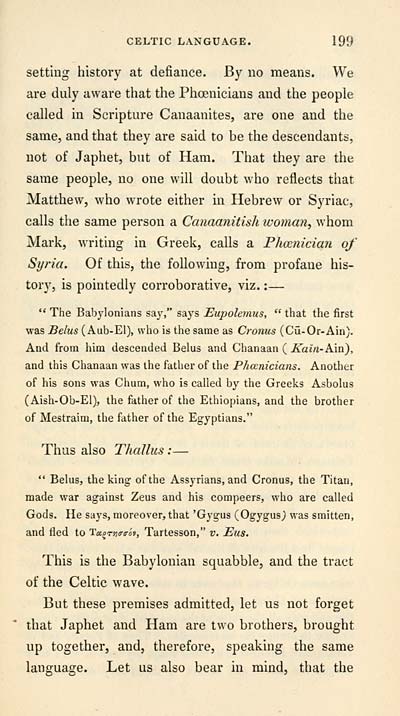Download files
Complete book:
Individual page:
Thumbnail gallery: Grid view | List view

CELTIC LANGUAGE. 199
setting history at defiance. By no means. We
are duly aware that the Phoenicians and the people
called in Scripture Canaanites, are one and the
same, and that they are said to be the descendants,
not of Japhet, but of Ham. That they are the
same people, no one will doubt who reflects that
Matthew, who wrote either in Hebrew or Syriac,
calls the same person a Canaanitish woman, whom
Mark, writing in Greek, calls a Phoenician of
Syria. Of this, the following, from profane his-
tory, is pointedly corroborative, viz. : —
" The Babj'lonians say," says Eupolemus, " that the first
was Belus ( Aub-El), who is the same as Cronus (Cu-Or-Ain).
And from him descended Belus and Chanaan ( ^am-Ain),
and this Chanaan was the father of the PJicenicians. Another
of his sons was Chum, who is called by the Greeks Asbolus
(Aish-Ob-El), the father of the Ethiopians, and the brother
of Mestraim, the father of the Egyptians."
Thus also Thallus : —
•' Belus, the king of the Assyrians, and Cronus, the Titan,
made war against Zeus and his compeers, who are called
Gods. He says, moreover, that 'Gygus (Ogygusj was smitten,
and fled to Ta^rn<r(ro>, Tartesson," v. Eus.
This is the Babylonian squabble, and the tract
of the Celtic wave.
But these premises admitted, let us not forget
that Japhet and Ham are two brothers, brought
up together, and, therefore, speaking the same
language. Let us also bear in mind, that the
setting history at defiance. By no means. We
are duly aware that the Phoenicians and the people
called in Scripture Canaanites, are one and the
same, and that they are said to be the descendants,
not of Japhet, but of Ham. That they are the
same people, no one will doubt who reflects that
Matthew, who wrote either in Hebrew or Syriac,
calls the same person a Canaanitish woman, whom
Mark, writing in Greek, calls a Phoenician of
Syria. Of this, the following, from profane his-
tory, is pointedly corroborative, viz. : —
" The Babj'lonians say," says Eupolemus, " that the first
was Belus ( Aub-El), who is the same as Cronus (Cu-Or-Ain).
And from him descended Belus and Chanaan ( ^am-Ain),
and this Chanaan was the father of the PJicenicians. Another
of his sons was Chum, who is called by the Greeks Asbolus
(Aish-Ob-El), the father of the Ethiopians, and the brother
of Mestraim, the father of the Egyptians."
Thus also Thallus : —
•' Belus, the king of the Assyrians, and Cronus, the Titan,
made war against Zeus and his compeers, who are called
Gods. He says, moreover, that 'Gygus (Ogygusj was smitten,
and fled to Ta^rn<r(ro>, Tartesson," v. Eus.
This is the Babylonian squabble, and the tract
of the Celtic wave.
But these premises admitted, let us not forget
that Japhet and Ham are two brothers, brought
up together, and, therefore, speaking the same
language. Let us also bear in mind, that the
Set display mode to: Large image | Transcription
Images and transcriptions on this page, including medium image downloads, may be used under the Creative Commons Attribution 4.0 International Licence unless otherwise stated. ![]()
| Early Gaelic Book Collections > Blair Collection > History of the Celtic language > (205) |
|---|
| Permanent URL | https://digital.nls.uk/76180864 |
|---|
| Description | A selection of books from a collection of more than 500 titles, mostly on religious and literary topics. Also includes some material dealing with other Celtic languages and societies. Collection created towards the end of the 19th century by Lady Evelyn Stewart Murray. |
|---|
| Description | Selected items from five 'Special and Named Printed Collections'. Includes books in Gaelic and other Celtic languages, works about the Gaels, their languages, literature, culture and history. |
|---|

